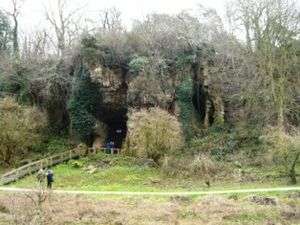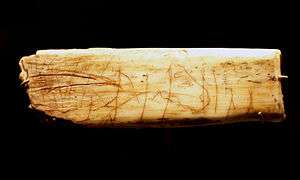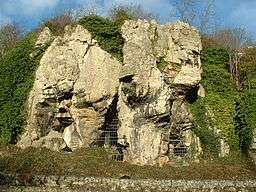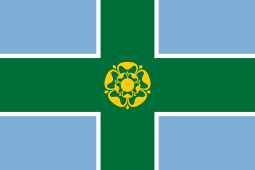Creswell Crags
| Creswell Crags | |
|---|---|
|
Caves at Creswell Crags | |
| Location | Creswell, Derbyshire |
| Coordinates | 53°15′40″N 1°11′16″W / 53.2612°N 1.1879°WCoordinates: 53°15′40″N 1°11′16″W / 53.2612°N 1.1879°W |
| Geology | Limestone |
Creswell Crags is a limestone gorge on the border between Derbyshire and Nottinghamshire, England, near the villages of Creswell and Whitwell. The cliffs in the ravine contain several caves that were occupied during the last ice age, between around 43,000 and 10,000 years ago. Its caves contain the northernmost cave art in Europe.
The caves contain occupation layers with evidence of flint tools from the Mousterian, proto-Solutrean, Creswellian and Maglemosian cultures. They were seasonally occupied by nomadic groups of people during the Upper Palaeolithic and Mesolithic periods. Evidence of Neolithic, Bronze Age, Roman and post-medieval activity has also been found there. There is evidence of Neanderthal occupation 50,000–60,000 years ago, a brief Gravettian occupation around 32,000 years ago and use of all the main caves during the Magdalenian around 14,000 years ago.[1] The site is open to the public and has a visitor centre with a small museum of objects associated with the caves, including a stuffed cave hyena.
As a result of its unique features, Creswell Crags has been designated as a Site of Special Scientific Interest (SSSI).[2][3]
The site was the subject of the BBC Radio 4 documentaries Unearthing Mysteries and Nature and featured in the 2005 BBC Two television programme Seven Natural Wonders, as one of the wonders of the Midlands.
In 2006–07, the B6042 road was re-routed from its path through the gorge, by approximately 150 metres (160 yd) to the north, to minimise traffic impact on the site.
Neanderthal and Upper Paleolithic occupation
The gorge has been visited by Neanderthals, and people from the Gravettian and Magdalenian periods.
Caves
The most occupied caves were:

- Mother Grundy's Parlour, which has produced numerous flint tools and split bones and was occupied until Mesolithic times.
- Robin Hood's Cave, the location of a bone engraved with a horse's head and evidence that its occupants hunted and trapped woolly rhinoceros and Arctic hare.
- The Pin Hole, the location of the Pinhole Cave Man, a human figure engraved on bone and discovered in the 1920s, and an ivory pin with etched lines.
- Church Hole, with more than 80 engravings on its walls and occupied intermittently until Roman times.
Finds


A bone engraved with a horse's head and other worked bone items along with the remains of a variety of prehistoric animals have been found in excavations since 1876. The "Ochre Horse" was found on 29 June 1876 at the back of the western chamber in the Robin Hood Cave.[5]
In 2003, the Ochre Horse was estimated to be between 11,000 and 13,000 years old.[6]
Cave art
In April 2003, engravings and bas-reliefs were found on the walls and ceilings of some of the caves, an important find as it had previously been thought that no British cave art existed. The discoveries, made by Paul Bahn, Sergio Rippoll and Paul Pettitt, included an animal figure at first thought to be an ibex but later identified as a stag. Later finds included carvings on the ceiling of Church Hole Cave, the rarity of which made the site one of international importance.[7]
To this day the finds at Creswell Crags represent the most northerly finds in Europe. Their subject matter includes representations of animals including bison and, arguably, several different bird species. Some workers, however, consider that the "bird" figures are more likely to be female anthropomorphs. The engravers seem to have made use of the naturally uneven cave surface in their carvings and it is likely that they relied on the early-morning sunlight entering the caves to illuminate the art.
Thin layers of calcium carbonate flowstone overlaying some of the engravings were dated using the uranium-series disequilibrium method, which showed the oldest of these flowstones to have formed at least 12,800 years ago.[6] This provides a minimum age for the underlying engraving. The scientists and archaeologists concluded that it was most likely the engravings were contemporary with evidence for occupation at the site during the late glacial interstadial around 13,000–15,000 years ago. Most of the engravings are found in Church Hole Cave on the Nottinghamshire side of the gorge. Since this discovery, however, an engraved reindeer from a cave on the Gower peninsula has yielded two minimum dates (through uranium-series dating) of 12,572 years BP and 14,505 years BP.[8]
Not all of the figures identified as prehistoric art are in fact human made. An example given by archaeologists Paul Bahn and Paul Pettitt is the 'horse-head', Which they say is ""highly visible and resembles a heavily maned horse-head... lacks any trace of work: it is a combination of erosion, black stains for the head, and natural burrow cast reliefs for the mane." Others are a 'bison-head' which they think may be natural and a 'bear' image which "lacks any evidence of human work." Notwithstanding they believe that more figures may be discovered in the future.[9]
See also
References
- ↑ "Palaeolithic art and archaeology of Creswell Crags, UK". Durham University. Retrieved 22 August 2013. The dates given in the source are 28,000 14C years ago for the Gravettian and 12,500 to 12,200 14C years ago for the Magdalenian. The 14C years have been adjusted to give calendar ('real') years. "The Radiocarbon age scale vs the 'real' (calibrated) years age scale.". Oak Ridge National Laboratory. Retrieved 30 January 2013.
- ↑ Natural England citation, Creswell Crags Archived March 4, 2016, at the Wayback Machine.
- ↑ Natural England, Nature on the Map, Creswell Crags
- ↑ The museum's exhibit label says "Leaf-points were probably spear tips. They are one of the earliest recognisable objects made by fully modern humans in Britain. This is a particularly good example. c. 38–35,000 years old"
- ↑ "Horse Engraving". Creswell Crags Museum & Heritage Centre. 11 July 2009. Retrieved 17 May 2013.
- 1 2 Hammond, Norman (7 December 2005). "Cave paintings reveal Ice Age artists". The Sunday Times. Retrieved 18 December 2010.
- ↑ Bahn, P. and Pettit, P., 2009, Britain's Oldest Art: The Ice Age Cave Art of Creswell Crags, London: English Heritage, ISBN 1-848-0202-52, ISBN 978-1848-0202-52
- ↑ "U-series dating suggests Welsh reindeer is Britain's oldest rock art". University of Bristol. 29 June 2012. Retrieved 10 July 2012.
- ↑ Bahn, Paul; Pettitt, Paul (2009). Britain's Oldest Art: The Ice Age Cave Art of Cresswell Crags: The Ice Age Cave Art of Creswell Crags. English Heritage. p. 85. ISBN 978-1848020252.
Further reading
- Bahn, P. "The Cresswell Caves Rock Art", Appendix VII in: Beckensall, S., (2009), Prehistoric Rock Art in Britain, Stroud, Amberley Publishing, ISBN 978 1 84868 626 7.
- Dawkins, W.B. (1877). "On the Mammal-fauna of the Caves of Creswell Crags". Quarterly Journal of the Geological Society. 33: 589–612. doi:10.1144/GSL.JGS.1877.033.01-04.35 – via wikisource.
- Dawkins, W.B.; Mello, J.M. (1879). "Further discoveries in the Cresswell Crags". Quarterly Journal of the Geological Society. 35: 724–735. doi:10.1144/GSL.JGS.1879.035.01-04.52.
- A.W.G. Pike, M. Gilmour, P. Pettitt, R. Jacobi, S. Ripoll, P. Bahn and F. Muñoz (2005) Verification of the age of the Palaeolithic rock art at Creswell, Journal of Archaeological Science 32, 1649–1655.
External links
| Wikimedia Commons has media related to Creswell Crags. |
- Creswell Crags website
- BBC News article on the cave art
- Listen to a BBC Radio 4 Programme - Unearthing Mysteries
- Listen to a BBC Radio 4 Programme - Nature, The Animal Image
- Historic England. "Palaeolithic and later prehistoric sites at Creswell Gorge including Pinhole Cave, Mother Grundy's Parlour and Robin Hood's Cave (1003770)". National Heritage List for England.
- Historic England. "Palaeolithic and later prehistoric sites at Creswell Gorge, including Boat House Cave and Church Hole Cave (1006384)". National Heritage List for England.

